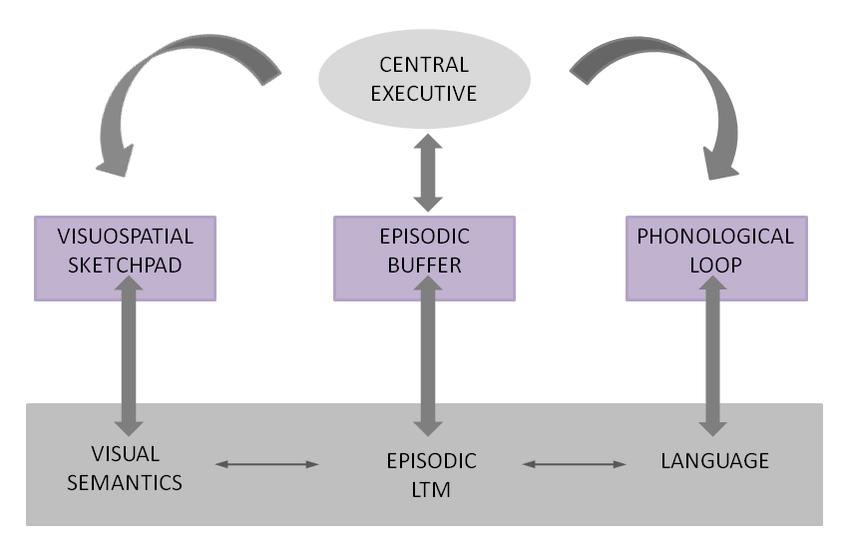Baddeley's Revised Model of Working Memory
By 1974, the time was ripe for a more elaborate theory of short-term memory that could account for emerging empirical findings. Considering the earlier models as overly simplistic, Baddeley and Hitch (1974) stepped forward to propose a multi-component model of short-term memory in which some components serve primarily as passive storage buffers while others process information.
The two British psychologists developed the idea of a working memory Opens in new window within short-term memory Opens in new window.
They defined working memory as a system for the temporary holding and manipulation of information during the performance of a range of cognitive tasks such as comprehension, learning, and reasoning (Baddeley, 1986, p. 34).
As originally proposed, Baddeley and Hitch’s multifaceted model comprised three aspects of working memory, namely: a phonological loop, a visuospatial sketchpad, and a central executive that controlled the other two subsystems referred to as slave systems.
In the years since then, the conceptualization of the working memory system has become increasingly complex. Following several studies, Baddeley (2001), proposed that the working memory system consists in four components (see Figure X-1):
- A modality-free central executive resembling attention.
- A phonological loop holding information in a phonological (speech-based) form.
- A visuo-spatial sketchpad specialized for spatial and visual coding.
- An episodic buffer, which is a temporary storage system that can hold and integrate information from the phonological loop, the visuo-spatial sketchpad, and long-term memory. It is controlled by the central executive. This component was added recently and is discussed here Opens in new window.

|
The key component of working memory Opens in new window is the central executive. It has limited capacity, resembles attention, and deals with any cognitively demanding task.
The phonological loop Opens in new window preserves the order in which words are presented, and the visuo-spatial sketchpad is used for the storage and manipulation of spatial Opens in new window and visual Opens in new window information.
All three components have limited capacity, and are relatively independent of the other components. Two assumptions follow:
- If two tasks use the same component, they cannot be performed successfully together.
- If two tasks use different components, it should be possible to perform them as well together as separately.
Numerous dual-task studies have been carried out on the basis of these assumptions. For example, Robbins et al. (1996) considered the involvement of the three original components of working memory in the selection of chess moves by weaker and stronger players. They selected continuation moves from various chess positions while performing one of the following concurrent tasks:
- Repetitive tapping: this was the control condition.
- Random number generation: this involved the central executive.
- Pressing keys on a keypad in a clockwise fashion: this used the visuo-spatial sketchpad.
- Rapid repetition of the word “see-saw”: this is articulatory suppression, which uses the phonological loop.
Selecting chess moves involved the central executive and the visuo-spatial sketchpad Opens in new window, but not the phonological loop Opens in new window.
The effects of the various concurrent tasks were similar on stronger and weaker players, suggesting that both groups use the working memory system in the same way.
In effect, Baddeley’s model is hierarchical, with the central executive as the top-level, domain-free factor that controls all the subcomponents. Apparently, Baddeley views the central executive as the essence of working memory; he usually refers to the subsidiary systems as short-term memory components.
See also:
- Adapted from:
- Cognitive Psychology: A Student's Handbook A book by Michael W. Eysenck, Mark T. Keane.
- Working Memory and Academic Learning: Assessment and Intervention. A book by Milton J. Dehn.

